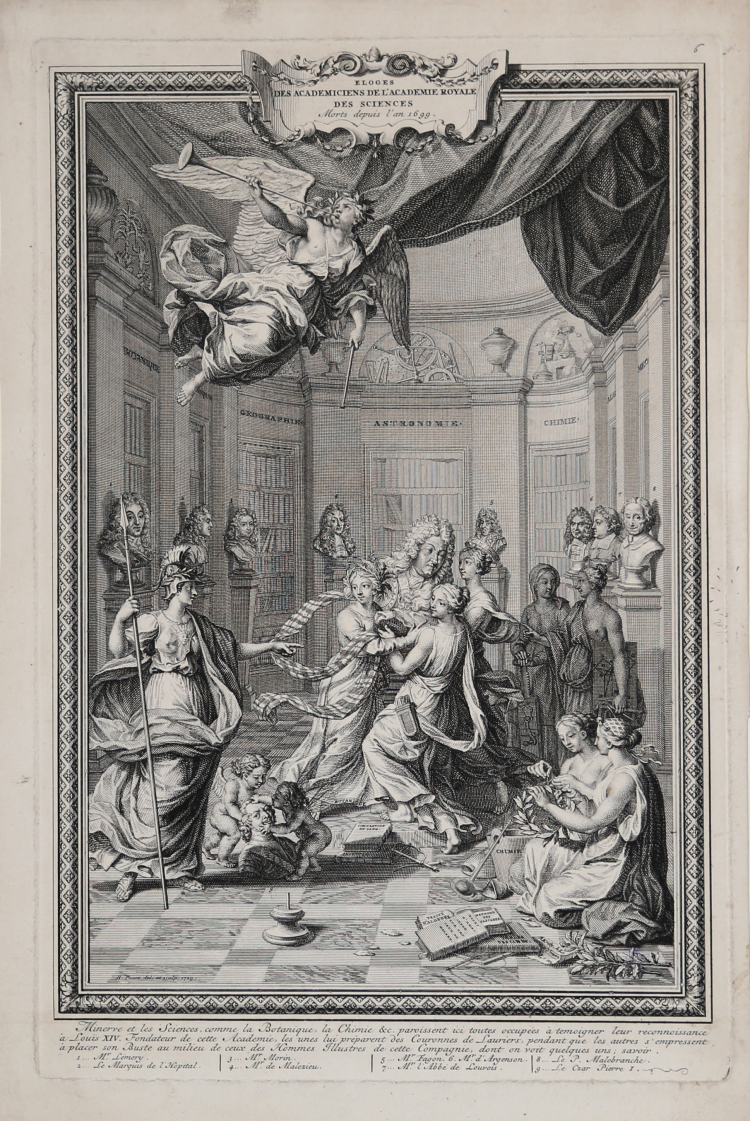



| Reference: | S31279 |
| Author | Bernard PICART |
| Year: | 1729 |
| Measures: | 205 x 308 mm |


| Reference: | S31279 |
| Author | Bernard PICART |
| Year: | 1729 |
| Measures: | 205 x 308 mm |
Etching and engraving, 1729.
Lettered with production detail: 'B. Picart del. et sculp. 1729', title: 'Eloges des académiciens de l'Académie royale des Sciences', three lines of inscriptions in French, and explanatory key.
Minerva and the Sciences setting a bust of Louis XIV in a room decorated with sculpted busts of other illustrious men; on the right, two personifications of Sciences are making laurel wreaths; above them flies Fame, who blows her trumpet; illustration to 'Eloges des académiciens de l'Académie royale des Sciences', in Fontenelle's 'Oeuvres diverses' (La Haye: Gosse & Neaulme, 1728-1729).
A fine impression, very good condition.
|
Dimier, Louis, Les peintres français du XVIIIe siècle, histoire des vies et catalogue des oeuvres, 1928, nn. 1500-1570.
|
Bernard PICART (Parigi 1673 - Amsterdam 1733)
|
Bernard Picart (Paris, June 11, 1673 - Amsterdam, May 8, 1733) was a French engraver. His father Etienne (1632-1721), known as the Roman, was well known for the excellence of his drawing and was his first teacher along with renowned artists of the time such as Sébastien Leclerc. In the brief biographical sketch compiled by his second wife, Anna Vincent, and published in Amsterdam soon after the artist's death, it is mentioned that the famous court painter Charles Le Brun paid attention to the artist, then 18 years old, when he received the prize of the Academy of Fine Arts. He moved to Antwerp in 1696, and spent a year in Amsterdam before returning to France in 1698 because of his mother's death and his father's ailments. After the death of his wife in 1708, he moved permanently to the Dutch capital in 1711, where he converted to Protestantism and married again. During this time Picart lent his happy hand to illustrate the books of authors who came to him. He depicted physiognomies, architecture, episodes and anecdotes told in the written pages, historical subjects, numismatics, portraits, costume scenes, gallant pastimes and chivalric activities that so appealed to the French, Dutch, Belgians and Swedes. Most of his works were collected in a kind of illustrated book, which included the Bible and Ovid. His most important work is Cérémonies et coutumes religieuses de tous les peuples du monde, edited by Jean-Frédéric Bernard between 1723 and 1743.
|
|
Dimier, Louis, Les peintres français du XVIIIe siècle, histoire des vies et catalogue des oeuvres, 1928, nn. 1500-1570.
|
Bernard PICART (Parigi 1673 - Amsterdam 1733)
|
Bernard Picart (Paris, June 11, 1673 - Amsterdam, May 8, 1733) was a French engraver. His father Etienne (1632-1721), known as the Roman, was well known for the excellence of his drawing and was his first teacher along with renowned artists of the time such as Sébastien Leclerc. In the brief biographical sketch compiled by his second wife, Anna Vincent, and published in Amsterdam soon after the artist's death, it is mentioned that the famous court painter Charles Le Brun paid attention to the artist, then 18 years old, when he received the prize of the Academy of Fine Arts. He moved to Antwerp in 1696, and spent a year in Amsterdam before returning to France in 1698 because of his mother's death and his father's ailments. After the death of his wife in 1708, he moved permanently to the Dutch capital in 1711, where he converted to Protestantism and married again. During this time Picart lent his happy hand to illustrate the books of authors who came to him. He depicted physiognomies, architecture, episodes and anecdotes told in the written pages, historical subjects, numismatics, portraits, costume scenes, gallant pastimes and chivalric activities that so appealed to the French, Dutch, Belgians and Swedes. Most of his works were collected in a kind of illustrated book, which included the Bible and Ovid. His most important work is Cérémonies et coutumes religieuses de tous les peuples du monde, edited by Jean-Frédéric Bernard between 1723 and 1743.
|